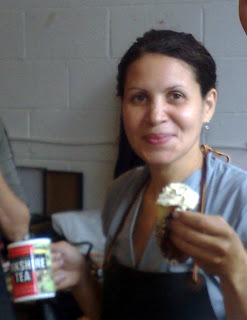I think our summer is over. We had a lovely June and July, but August has been a washout and today is cold, like Autumn, but never mind. It means the season of hard work is here and without the distractions of the hot weather, we can really sink our teeth into some new challenges.
Now, the title of this week's post is The Seat. That tricky part of the shoe where the heel meets the upper. When I cut it, it really marks for me the moment when the shoe starts to look like a proper shoe. It is a small job, but it makes a marked difference, and when done well, it looks great.
The trick is to get a thin and even seat, and here's how you do it.
Here you have the heel built and waist done, but as you can see, it is all messy and uneven. The heel is marked on both sides and this is the point I cut the seat.

First I mark the waist to the desired thickness, a quarter inch in this case. I do it by eye and then check it.

Now the seat. You need to mark a line from one heel point to the other. I use a tape measure and lay it on the seat all the way round. This gives you a level line. Hold the tape measure steady with all your fingers and draw a line with a pen.
Make sure the line meets up with the lines on the waist, so that the transition is smooth.


When you have the line, hold the shoe up and check that it is even all the way round. If it is not, make any adjustments you need to.

Starting at the waist, you need to cut along your lovely even line, all the way to the other waist mark. Open up the waist with your sleeking bone and wet the leather, including the seat. I place a piece of plastic behind the knife to protect the upper.

However, on the seat, you cannot protect the upper, so you have to be very careful and cut the seat along your pen line. Make sure it is even and straight.

At this point you have a wide edge on both the waist and the seat, which you will need to trim close to the upper.


Cut with the tip of your knife, so that the edge is just less than 1mm wide. You can use the plastic again to protect the upper.

On the seat, trim to about 1mm. Just make sure it is even all the way round. Use the plastic to protect the upper. For the thrill seekers amongst you who have a sharp knife, you can do this unprotected, but we do not advise this.

The seat is now completed. Peen it tight to the upper with the French shape hammer. Do the same on the waists. Cut the heel breast on the lines you have marked. You will notice at this point that the heel is out of shape again and you will need to reshape it to be in line with the new seat. Use your knife! All shaping should be done with the knife. Rasping is just to make the leather look smooth and free of blemishes.


Hope that helps.
And that, as they say, is that. For this week, at least.
So, until next week, happy shoemaking.






























